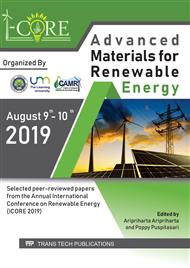p.149
p.156
p.164
p.172
p.184
p.197
p.205
p.212
p.220
Activation of Zeolite from Malang as Catalyst for Plastic Waste Conversion to Fuel
Abstract:
Plastic pollution is an environmental problem that has not resolved until now. Pyrolysis is able to be a solution to reduce plastic waste. The use of catalysts will reduce heating temperatures, speed up processing time, and increase product yield. Natural zeolite has the potency as a catalyst in pyrolysis process due to its micropore structure, high acidity and thermal stability. The purpose of this research is to determine the effect of active zeolite catalyst on the polypropylene pyrolysis. The main process of this study is pyrolysis of polypropylene (PP) plastic waste without catalysts and with natural zeolite catalysts which were non-activated and activated. Natural zeolites were activated by HF, HCl and NH4Cl. The well result of this research is represented by the yield, viscosity, calorific value, FTIR and GC-MS analysis. Based on the results of diffractogram analysis, natural zeolites catalyst in this study is included in modernite minerals crystalline. The ratio of Si/Al in zeolite before activation was 7.07 and the acidity was 0.697 g/mmol. After the activation process, the ratio of Si/Al and zeolite acidity increased by 62.181% and 43.84%. The use of active natural zeolite catalysts in pyrolysis PP could reduce the total reaction time by 57.14%. Pyrolysis products with active zeolite catalyst compared to without catalysts had clearer color and higher heating value, compared to pirolysis without catalyst. Based on function group analysis with FTIR, the mixture of hydrolyzed compounds containing successive functional groups are-C-H (alkanes), double bond of C=C, hydroxyl-OH group which can be determined as phenol (ArOH), alcohol (ROH), and carboxylic acid (RCOOH). The GC-MS analysis showed that pyrolysis products are composed of a mixture of alkanes, cycloalkanes, alkenes, carboxylic acids with aromatic rings, and ketones. The pyrolysis products without catalysts consist of 5-11 (C5-C11) carbon atoms, whereas the range of carbon atoms of pyrolysis products with active zeolite catalysts was 6-24 (C6-C24).
Info:
Periodical:
Pages:
212-219
Citation:
Online since:
July 2020
Keywords:
Price:
Сopyright:
© 2020 Trans Tech Publications Ltd. All Rights Reserved
Share:
Citation:


